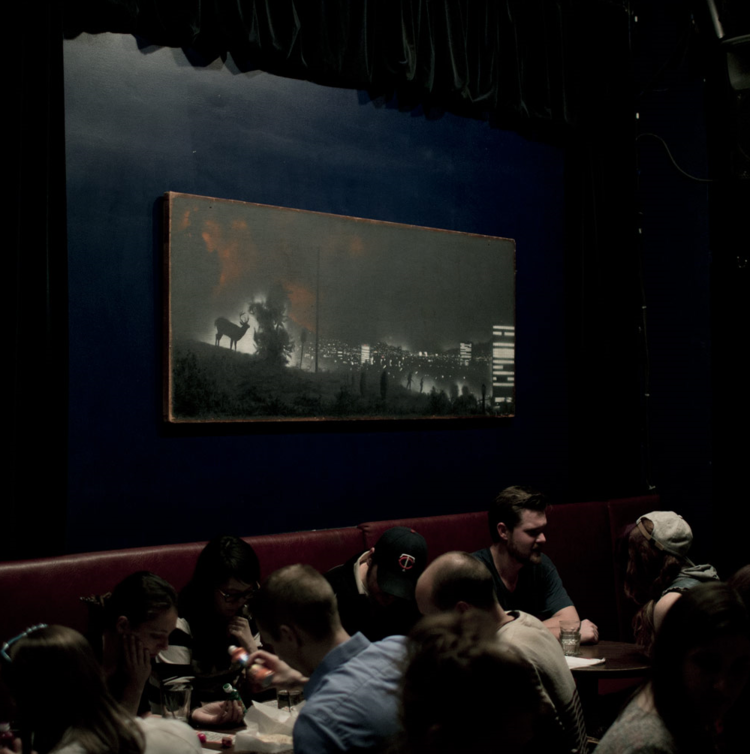
Andy Sturdevant interviews Jon Oulman
Andy Sturdevant: We should begin by taking about how you got into running a gallery and showing artwork. You’d met John in the 1980s and shown his work then, correct?
Jon Oulman: Yes. There were two-dozen galleries around the Wyman Building at one point, where my gallery was. It was like a 20th century Lower Manhattan sort of situation – like SoHo, very densely populated. That had a long run – from ’83, ’84 to ’96 or so. Thom Berry, Bob Thompson and I opened galleries, and started coordinating our openings, and started with three in 1983. By 1990, there were all these galleries, all operating at the same time. There was this period where it was really vibrant.
I was going to New York at least eight or nine times a year. Most of the people I showed locally were from New York.
John was showing with Holly Solomon at the time. There was a gallery director for Holly who I met her through another photographer and painter. We were talking, and she said, ‘I think you’d like this guy’s work.’ And, in fact, Crossings was the first painting of his I saw.
AS: That’s auspicious.
JO: It is. I contracted to show that painting and some other work by him – it was some more mechanical stuff. He did pieces where he’d take paint rollers, and carve and cut these things. Very cool stuff. So for a while, I’d show his work every few years in Minneapolis.
AS: How did his work relate to other work you were showing at the time? What stood out with his paintings?
JO: Certainly he’s a romantic painter. The romance may not be all love and rockets…well, the rockets are in there. (laughs) But I was attracted to the romance of the earth, and the ideas about the environment that are in there. There’s a conflict with authority that comes through in the military imagery. There’s always conflict in the work, against a landscape. They evoke a sense of place, and reference specific places, even if they seem to exist just out of the real world.
There’s a surrealist quality. And you often see a sort of proletariat represented – there’s a horizon line filled with people. At Amsterdam, there’s a gold and yellow painting of the St. Paul Cathedral, and in the foreground there’s this subtle line of people outside – it’s ingenious how he makes his mark with the brush, it’s just [imitates sound of brush lightly crossing the canvas] and there’s a dude with a ball cap. There’s this timeless, old world stuff, like the cathedral, and also eastern European things in his work, and then you’ll see MiG fighter jets, tanks…

AS: How do you feel about showing the work in a gallery space versus a public gathering space like the 331? Both types of venues give people a chance to get know the work, but the type of contact is very different.
JO: In either setting, my favorite part about exhibiting work and selling work was the show-and-tell, curating a body of work that had something to say. You bring it here in hopes of selling it, but also the opportunity to take that point of view into people’s lives, in a way that they get to live with it. Even if they’re not looking at it all the time, it’s there. Even if they’re just walking by – you walk by something every day for years, you don’t have to look at it, but it makes an impact on you. I like bringing that kind of thing in people’s home.
When I bought the 331, I wanted it to not just be a dive bar, but also be a place where you would engage people with entertainment, with music. For me, it was also an outlet culturally. I started by hanging artwork – not just Crossings, but a few other pieces – and I wanted to rotate work every few months. It got the point where I got sick and tired of people asking about that painting, but I just thought fuck it, I’ll just leave it.
It does shift. There was s guy in there recently asking me about a few Duncan Hanna pieces I’d had there – newsprint decoupaged to marine plywood. He asked, “Whatever happened to those drawings?” I said, Man, that was ten year ago. “Was it?” I thought, oof, I’d better buy this guy a drink – he wanted to buy artwork that were here ten years ago. But I hadn’t taken the painting of John’s off the wall in ten years. Just to paint the wall or dust behind. It’s been the constant.
AS: How did you decide to show a selection of John’s work? Was it specific to Art-A-Whirl?
JO: It just started with a phone conversation with John. It actually started last fall. I opened two restaurants then, and to people in my life, I was whining I don’t want to just be a restaurant guy. I’d been looking for a little building – a clubhouse kind of thing where I could do events, host exhibitions, maybe performance – like an art space, or a playhouse. I was having a conversation with John about not wanting to run a gallery and do nine shows a year. Too much work, too little reward! But I did want to be involved in that community again, and he said, well, then let’s do a show.
And it just dawned on me one afternoon in September: what about Art-A-Whirl? People keep talking about this painting, so let’s do something on that, let’s build on that – we could hang something in the 331, and at the Sheridan Room, and at my home. That painting is a story. It just made sense to do something.

AS: Yeah. I think, for a lot of people – like a lot of John’s work, it’s very accessible, but it’s also very weird.
JO: It is weird. It’s link a Rorschach blot. Easy to interpret, and make a narrative, and everyone’s going to make their own narrative. His work is accessible that way, in that you can create a narrative. And he puts these little iconic figures in there, and whether its buildings or wolves or coyotes or tanks, people can relate to it. It’s like dream imagery.
I’ve always been attracted to work that has some sense of representation – at least on foot in the real world, as a departure or launching pad. I enjoy creating narratives – they’re easy to talk about. You talk about things if there’s a story there. If you have to share the more dry aspects of art history in order to understand a piece, you’re limiting who you can talk to. It becomes elitist. It’s no fun.
AS: There’s such a huge audience for Art-A-Whirl. Even people who might not have attended ten years ago – now, people come right to the middle of the neighborhood, where the 331 and Sheridan Room are, for the beer and the music. You’ve got a great audience.
JO: We’ve had stages for ten years. We can do not just music, but also remind people it’s more than just a party. It comes out of art. It goes back to the audience Crossings has had at the 331. The way people respond to his work, and that piece in particular because over the last ten years, tens of thousands of people have seen it. And so many of those people talk about it.